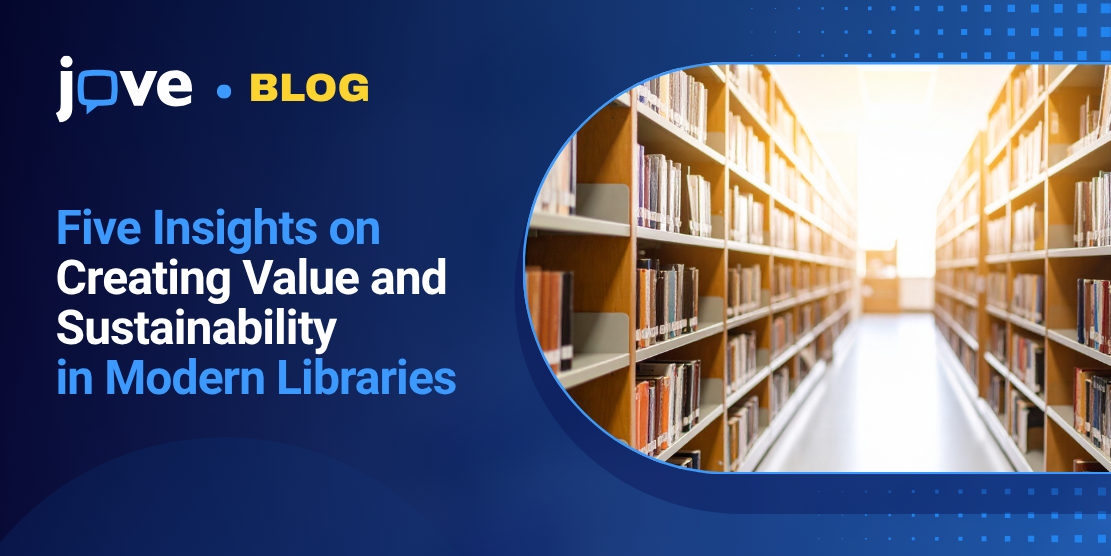Behind every thriving academic program is a library that invests with purpose. The most effective collections aren’t simply extensive—they are intentional, chosen for how well they advance teaching, research, and student success. Each decision a librarian makes, from renewing a journal to piloting new formats, has a ripple effect that extends far beyond the current semester.
In the JoVE webinar How Strategic Library Investments Drive Long-Term Savings, librarians from across the world led different sessions and discussed how thoughtful, data-driven choices can transform library collections into lasting institutional assets.
Five themes stood out from their conversations, each offering a perspective on how libraries create sustained value through thoughtful investments.
1. Longevity Outlasts Cost
Sustainability in libraries begins with perspective. Dr. Sandeep Pathak of IISER Bhopal described the smart library as "a growing organism"—one that evolves through systematic effort and continuous improvement.
He explained that rather than focusing on immediate savings, many librarians now look for ways to make each resource relevant to more people and purposes. When the same collection serves students, instructors, and researchers, it strengthens the value proposition of the library itself.
Each use case reinforces another, turning a single investment into a versatile tool for teaching, learning, and discovery. In this way, the collection’s impact becomes self-sustaining, growing with every new integration across the institution.
2. Data Turns Insight into Strategy
Across all sessions, speakers agreed that clear evidence helps librarians see the full picture before acting. Meaningful analytics, such as access trends, user engagement patterns, and direct feedback from faculty, help librarians see not only how often a resource is used, but how it advances learning and research in practice.
Dr. Pathak noted that “data helps move from assumptions... to clarity,” a shift that strengthens conversations with faculty and leadership alike. When librarians share clear, evidence-based insights, renewal conversations shift from budget defense to shared planning.
3. Collaboration Extends Reach
Whitney Bates-Gómez of Emory University highlighted that true impact comes from relationships built on understanding and accessibility. She explained that being able to “approach users and meet users where they’re at” is something she carries into her daily work. This approach turns collaboration into a shared habit rather than a one-off project.
When libraries, faculty, and publishers stay in close conversation, a resource becomes more than a subscription; it becomes something the whole community uses and supports. Shared workshops, co-created teaching materials, and joint training sessions help everyone feel invested in how those materials are used. When people across campus contribute to a resource’s success, it naturally reaches farther, supported by collaboration tools and teaching platforms that help keep those connections active..
4. People Sustain Progress
Emma Brady from the University of Florida reminded attendees that technology alone does not create innovation. “Training and outreach determine whether tools reach their potential,” she explained. A platform only fulfills its promise when the people around it know how to use it with confidence and purpose.
When staff know how to interpret usage data, support digital learning, and guide faculty and students toward the right materials, access becomes meaningful. Their efforts lead to higher engagement, deeper understanding, and stronger connections between research and learning. As awareness grows, so does the return for the entire academic community.
5. Transparency Earns Trust
Finally, every speaker emphasized the value of showing the impact of library investments. Sharing stories of success, such as how a resource supported a new course, improved student outcomes, or saved researchers time, helps others see the library’s role in advancing institutional goals.
Dr. Pathak explained that his team ensures transparency by openly sharing renewal costs, usage statistics, and faculty recommendations. Each year, they review how often journals are accessed, compare costs across departments, and present this data to decision-makers. By making data visible and tying renewals directly to demand, the library demonstrates clear value and accountability for every resource it maintains.
Stewardship for Lasting Impact
Strategic investment in libraries is an act of trust: trust in data, in people, and in the belief that knowledge expands when it is shared with purpose. Each informed decision strengthens the foundations of teaching and discovery for years to come.
Sustainability in libraries begins with reflection and adaptability. When libraries use evidence to refine their choices and respond to changing needs, they create systems that improve over time rather than simply endure. Every evaluation becomes a step toward greater alignment between resources and the people they serve.

